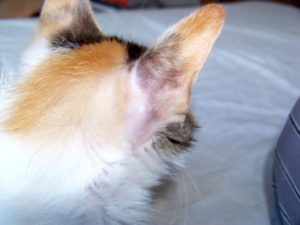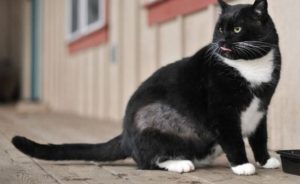Synonyms: alopecia, baldness; falling of the fur.
Alopecia may be manifested locally or generally, and although widespread baldness in cats is exceedingly rare, it has been seen sometimes in kittens, whole litters of long-haired kittens having been effected without any apparent cause. Even localized alopecia is not of common occurrence in these animals, except upon a small area situated just below the auricular orifice on each side of the face. In adult cats, the sparseness of hair in this region is so frequently observed that it appears to be almost a normal condition. Kittens do not exhibit this peculiarity. 
Generalized alopecia, not necessarily resulting in a complete loss of hair, may be observed after long or severe illnesses. Localized bald patches may arise from ringworm, eczema, follicular mange, or burns. In the latter case, the condition would probably be permanent since the destruction of the hair follicles takes place in all burns of a severe character. As a result of irritation of the skin, cats will often scratch their fur away, and in view of the great prevalence of otoacariasis in cats, the sparsely covered areas above the cheekbones (already alluded to) might well arise as a result of constant irritation and scratching of the base of the ear. The writer is aware that alopecia may also be caused by inbreeding, or by malnutrition of the skin due to some interference with the blood or nerve supply. But he does not believe that either of these factors enters into the etiology of alopecia in this species has yet been recorded.
Symptoms of the alopecia
 In those cases in which the condition is the direct result of a scald or wound there is no symptom other than a denuded and scarred skin. In alopecia having a parasitic origin, more or less irritation, and perhaps pityriasis, will most likely be present. In other instances in which no cause whatever can be found to account for the loss of hair, the skin is usually supple, smooth, and clean. Cats shed their coats in the spring and autumn seasons, as do dogs, but not to the same extent.
In those cases in which the condition is the direct result of a scald or wound there is no symptom other than a denuded and scarred skin. In alopecia having a parasitic origin, more or less irritation, and perhaps pityriasis, will most likely be present. In other instances in which no cause whatever can be found to account for the loss of hair, the skin is usually supple, smooth, and clean. Cats shed their coats in the spring and autumn seasons, as do dogs, but not to the same extent.
Cat Hair Loss Treatment
Where causes can be ascertained, these should be removed by appropriate treatment. Pruritus, for instance, must be subdued, parasites exterminated, and mechanical irritation checked. A seasonal change of coat may be expedited by brushing the cat twice daily, the quiche to remove hairs which would fall in any case, and to make room for the new growth. In addition, such grooming acts as a useful stimulant to the hair follicles by increasing the circulation. Hair which falls as a result of the general loss of tone or stamina, such as occurs sometimes after long illnesses, procreation of young, or starvation, may be treated with stimulating lotions applied daily with friction, and the administration of general tonics.
Very good flea repellent for cats misery hair loss due to parasites is a citrus solution. You should cut a lemon in quarters and place the parts in a pot of boiling water. Then let this overnight. Spray over the entire cat, mainly behind the ears, head, tail and in the arms. Garlic, brewer’s yeast tablets, and apple cider vinegar all work as an internal flea repellent. They all excrete smells or acids into the skin of the cat and make it an unfriendly environment for fleas.
Weekly baths can help get free of excess hair but use natural ingredients in the cat shampoo. Also, chamomile added to a cat’s bath can help reduce dandruff and promote healthy skin and coat and nettle can be used to support healthy skin and hair. 
Simultaneously with this external treatment, the quality of the blood and the general health of the cat should be improved by the administration of suitable tonics internally. In this connection, the vitalizing effects of cod-liver oil should not be forgotten (omega-3, for ex. Duralactin).
Talk your Vet
If your pet cat shows any of the clinical signs listed earlier, make sure what is it and visit your veterinarian. The cat’s doctor can discuss the best treatment scheme with you.
We hope that this article was useful and helps you find the right treatment for your cat! Are you use for your pet – please, let us know what keeps your pet healthy in the comments! 🙂


